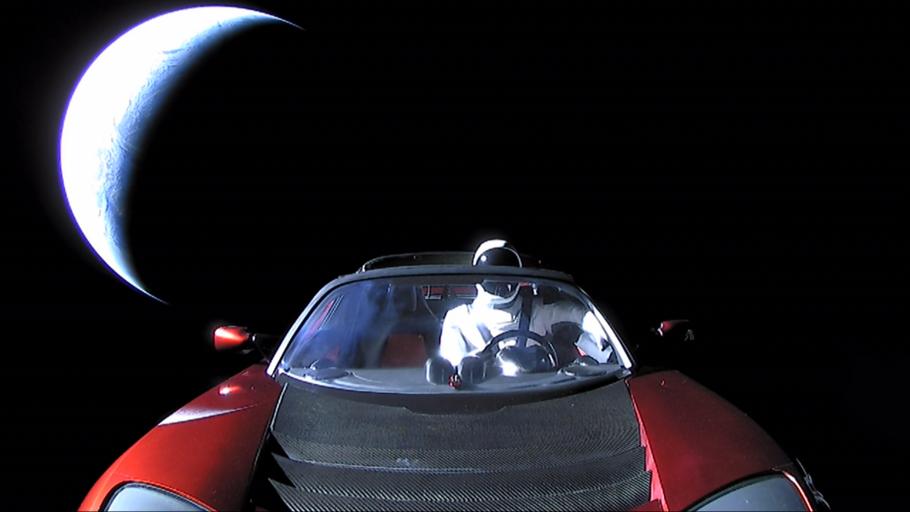When you watch astronauts Bob Behnken and Doug Hurley make their way out to the SpaceX Crew Dragon capsule to launch to the International Space Station on the Demo-2 mission, you will notice that their spacesuits look different than the ones you are used to seeing. They appear sleeker than the Sokol launch and entry suits that astronauts wear for launch onboard the Soyuz capsule that has been carrying crews to the ISS for the last nine years. They bear even less resemblance to the orange "pumpkin suits," also known as Advanced Crew Escape System (ACES) suits, that Space Shuttle crews wore when riding the shuttle to orbit or the space station. It should not be surprising that the suits, like many things related to Elon Musk's SpaceX operation, intentionally look unlike anything that has gone before them.
Custom Image Caption
Astronauts Doug Hurley and Chris Ferguson in orange ACES launch-and-entry suits.
Custom Image Caption
Astronauts Nick Hague and Christina Koch in Sokol pressure suits.
Custom Image Caption
Bob Behnken and Doug Hurley in SpaceX spacesuits.
Launch and entry suits that astronauts wear at the start and finish of their missions are incomplete versions of the human-shaped spacecraft that explorers use outside of the spacecraft in open space. These suits provide added safety to the astronauts during the most dangerous phases of the missions, like when they travel through the Earth's atmosphere, but they are not autonomous. The suits rely on the life support and communications systems of the spacecraft to protect life in the event of a failure of the capsule's primary life support systems. Traditionally these suits have been adaptations of pilots' high-altitude suits that mostly serve the same purpose. Thus, they have the affectionate moniker of "get me down" suits.
In his own style, entrepreneur Elon Musk has re-choreographed the line between fantasy and reality, taking what had once been fantasy and turning it into a new reality. The Dragon suits are an example of this practice. In 2016, Elon Musk hired Hollywood costume designer Jose Fernandez to design a spacesuit for his firm. Fernandez is better known for creating costumes for superheroes in films such as Batman v Superman: Dawn of Justice (2016). Musk wanted his suits, like his capsule and launch vehicles, to look like something that had never been seen before.
Fernandez took inspiration from Musk when creating an all-black costume that resembled the suit from the movie Iron Man (2008). Posed in this newly designed costume for a Vogue photoshoot, Musk resembled none other than the fictional billionaire-turned superhero, Tony Stark. The all-black L&E suit was set to contrast sharply with the sleek white interior with black details of the Dragon capsule.
Of course, costume designers are not spacesuit engineers. The next step that SpaceX had to accomplish was transforming Fernandez's costumes into actual functional spacesuits. He turned the design over to spacesuit engineers currently working in the field to make it useful. We don't exactly know who was involved or how this was done—like much of the company's operations, the work was secret and shielded by confidentiality and non-disclosure agreements. But in that effort to retrofit a Hollywood costume into a spacesuit, we do know that the final product retained some aesthetic design elements from the original.
Elon Musk's Tesla Roadster with a mannequin wearing SpaceX spacesuit in the driver's seat. The car was launched into space via a Falcon Heavy rocket in 2018.
Musk revealed the first hints of what stayed and changed in the prototype when he launched a 2008 Tesla Model S roadster on a test launch of the SpaceX Falcon Heavy rocket in 2018. In the driver's seat of the car was a mannequin wearing a spacesuit. In a dramatic twist, instead of the black design, the suit was almost all white. One of the changes that the spacesuit engineers must have made was to change the heat-absorbing all-black outfit into an all-white one that could reflect the bright sunlight.
Astronauts Bob Behnken and Doug Hurley walk through Crew Access Arm in SpaceX spacesuits during a dress rehearsal for the first crewed SpaceX launch.
Beyond the cover layer, it is premature to speculate on the inner workings of the suit. To date, there have only been a handful of people who have had the luxury of fully exploring the inner workings of these new launch and entry suits. As SpaceX operations expand, more and more details will come to light. And in the fullness of time, Museum conservator Lisa Young and I will get our hands on one to fully document and preserve. We have many questions that we would like to answer, including: Which materials are used? How is the ventilation routed throughout the suit? How do the astronauts communicate? Where does the suit connect to the Dragon? We both look forward to sharing that information with you sometime soon.
Commercial crew astronaut Doug Hurley dons a SpaceX spacesuit in January 2020.
NASA commercial crew astronauts Bob Behnken and Doug Hurley shake hands in SpaceX spacesuit in January 2020.
The sleeve of commerical crew astronaut Bob Behnken's SpaceX spacesuit, photographed in March 2020.
Cathleen Lewis is curator of spacesuits at the Smithsonian’s National Air and Space Museum.

